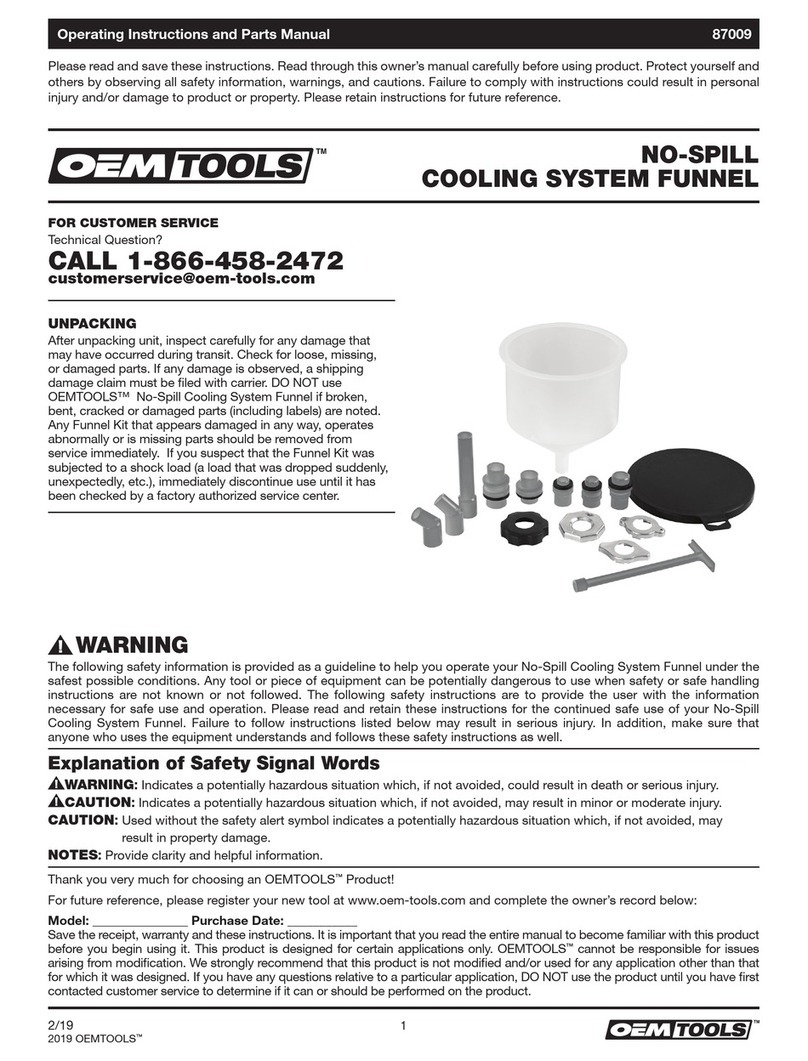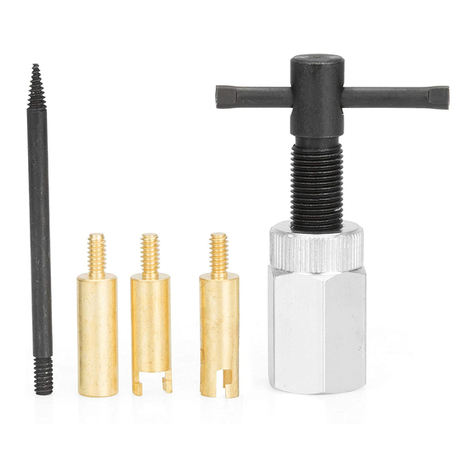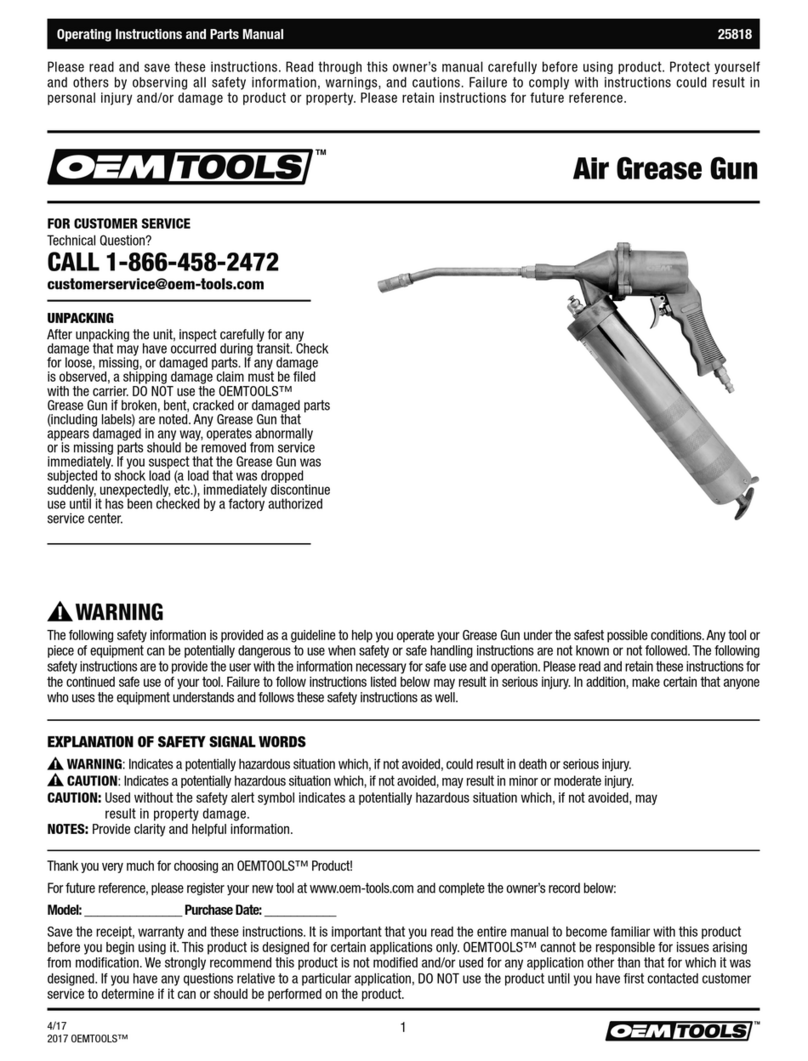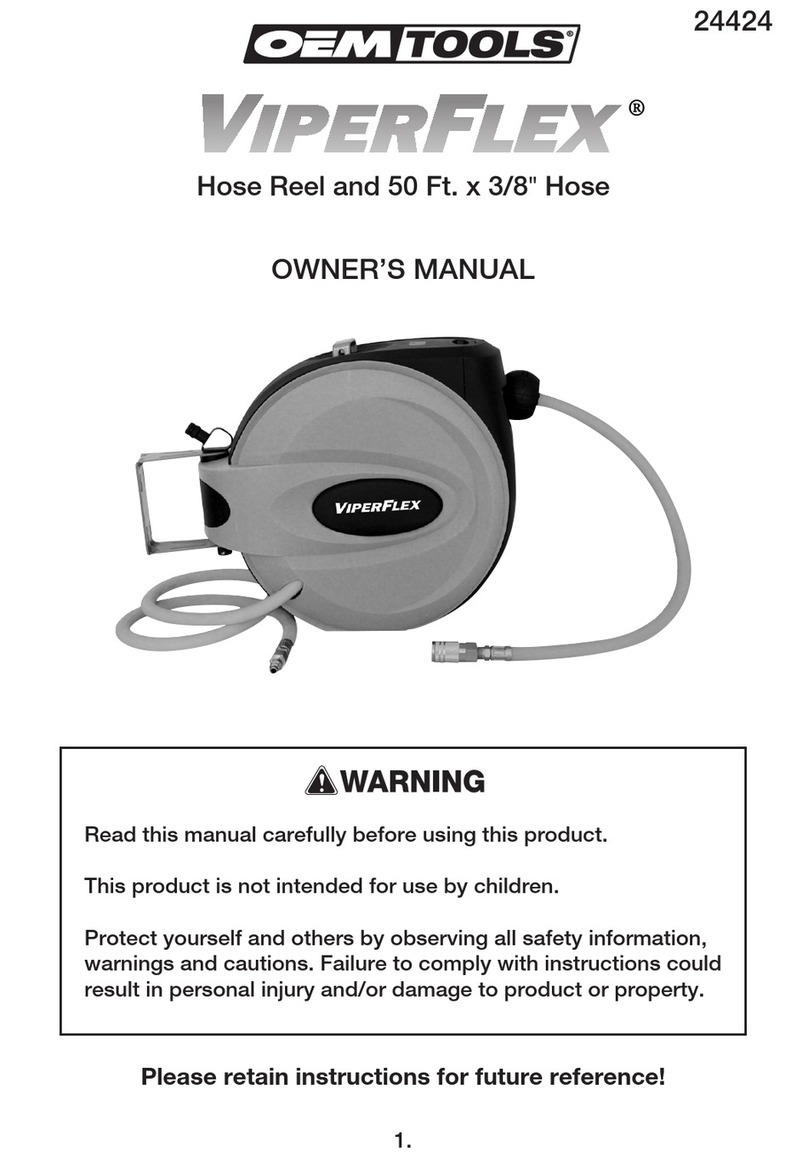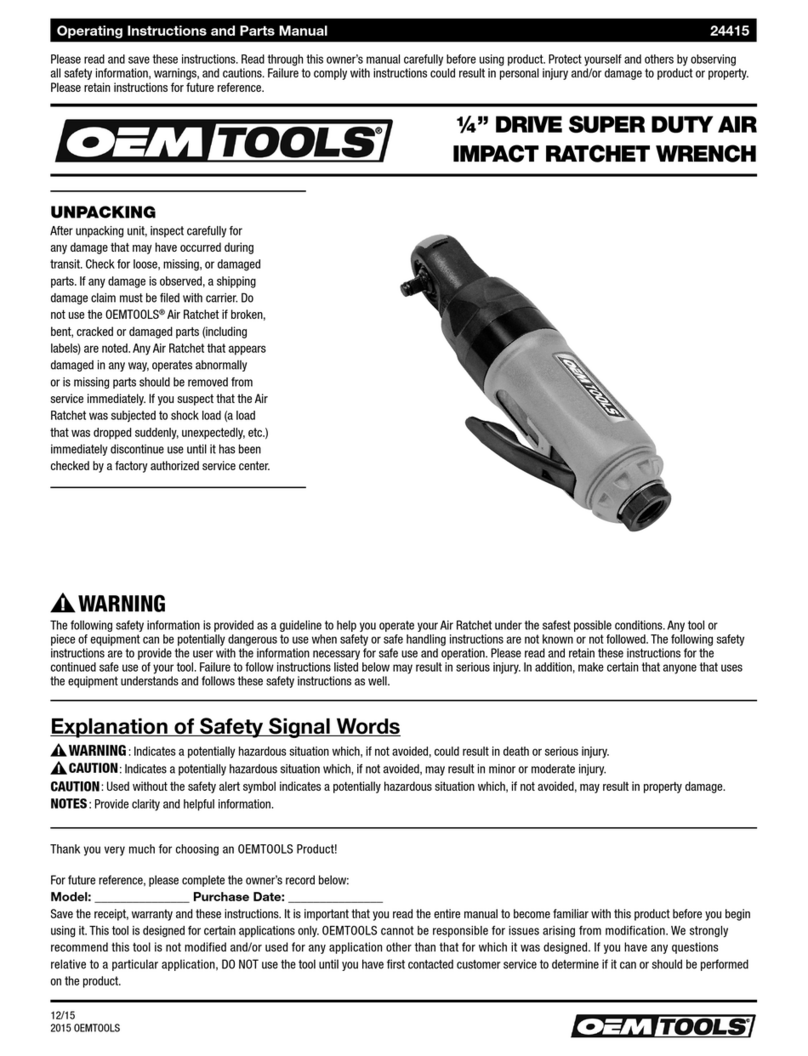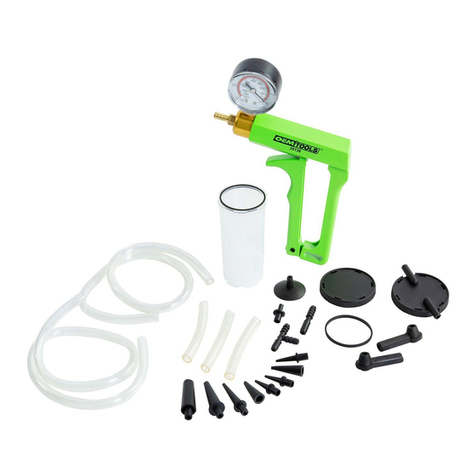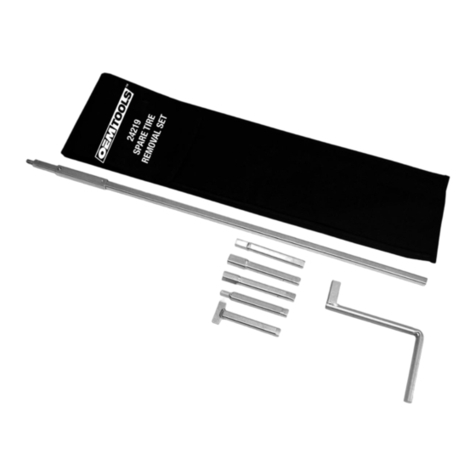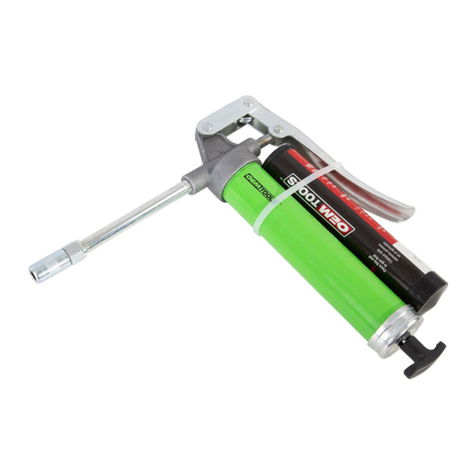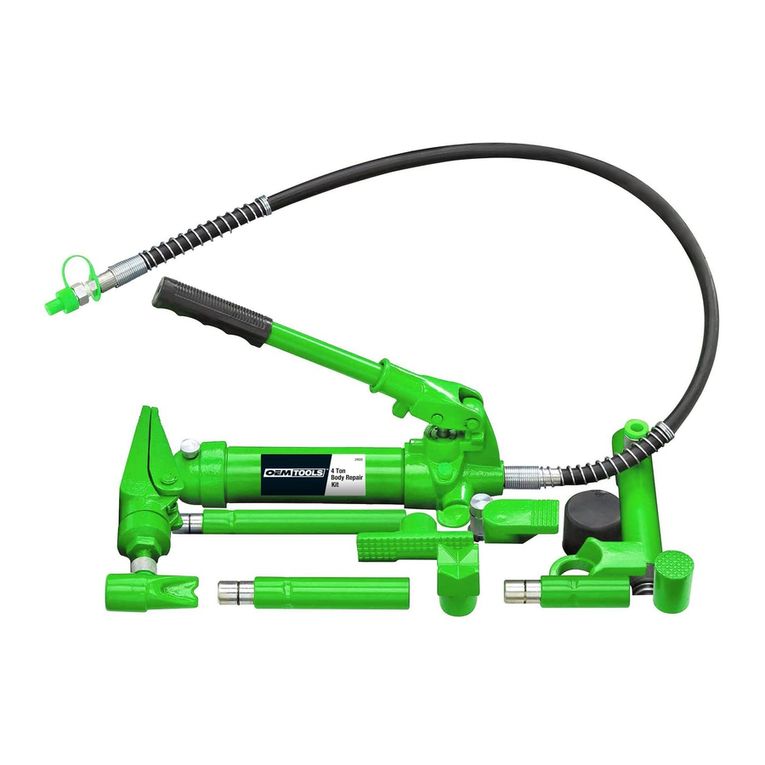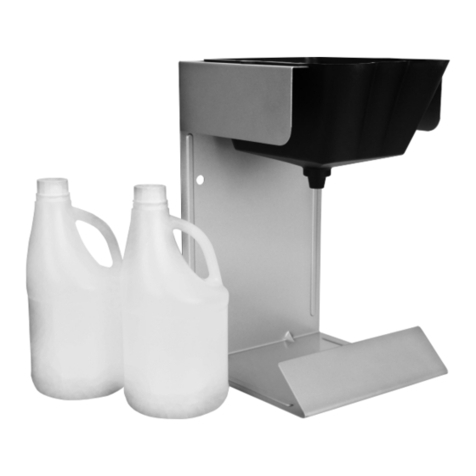
2
Operating Instructions and Parts Manual 24449
5 GALLON
TIRE BEAD SEATER
2/17
2017 OEMTOOLS®
IMPORTANT INSTRUCTIONS
AND SAFETY RULES
1. Know your tool. Read this manual carefully. Learn the tool’s
applications and limitations, as well as, potential hazards specific to it.
2. Keep work area clean and well lit. Cluttered or dark work areas
invite accidents.
3. Keep children away. All children should be kept away from the work
area. Never let a child handle a tool without strict adult supervision.
4. Do not operate this tool if under the influence of alcohol or drugs.
Read warning labels on prescriptions to determine if your judgment
or reflexes are impaired while taking drugs. If there is any doubt, do
not attempt to operate.
5. Use safety equipment. Eye protection should be worn at all times
when operating this tool. Use ANSI approved safety glasses.
Everyday eyeglasses are NOT safety glasses. Dust mask, non-skid
safety shoes, hard hat or hearing protection should be used in
appropriate conditions.
6. Wear proper apparel. Loose clothing, gloves, neck-ties, rings,
bracelets or other jewelry may present a potential hazard when
operating this tool. Keep all apparel clear of the tool.
7. Don’t overreach. Keep proper footing and balance at all times when
operating this tool.
8. Check for damage. Check your tool regularly. If part of the tool is
damaged it should be carefully inspected to make sure that it can
perform its intended function correctly. If in doubt, the part should
be repaired. Refer all servicing to a qualified technician. Consult
your dealer for advice.
9. Keep away from flammables. Do not attempt to operate this tool
near flammable materials or combustibles. Failure to comply may
cause serious injury or death.
10. Store idle tools out of the reach of children and untrained persons.
Tools may be dangerous in the hands of untrained users.
11. Maintain tools with care.
12. Keep tools dry and clean.
13. Properly maintained tools are less likely to bind and are easier to
control. Do not use a damaged tool. Tag damaged tools “Do not use”
until repaired.
14. Check for misalignment or binding of moving parts, breakage of
parts, and any other condition that may affect the tool’s operation.
15. If damaged, have the tool serviced before using. Many accidents are
caused by poorly maintained tools.
16. Use only accessories that are recommended by the manufacturer
for your model. Accessories that may be suitable for one tool may
become hazardous when used on another tool.
17. Tool service must be performed only by qualified repair personnel.
Service or maintenance performed by unqualified personnel could
result in a risk of injury.
18. When servicing a tool, use only identical replacement parts. Use of
unauthorized parts or failure to follow maintenance instructions may
create a risk of injury.
19. Maintain a safe working environment. Keep the work area well lit.
Make sure there is adequate surrounding workspace. Keep the work
area free of obstructions, grease, oil, trash, and other debris. Do not
use this product in a damp or wet location.
20. Maintain labels and nameplates on this product. These carry
important information. If unreadable or missing, contact OEM for a
replacement.
21. Keep the handle dry, clean, and free from brake fluid, oil, and
grease.
22. Before use, read and understand all warnings, safety precautions,
and instructions as outlined in the vehicle manufacturer’s service
manual. It is beyond the scope of this manual to properly describe
the correct procedure and test data for each vehicle.
23. Always perform vehicle service in a properly ventilated area. Never
run an engine without proper ventilation for its exhaust. Stop work
and take necessary steps to improve ventilation in the work area
if you develop momentary eye, nose, or throat irritation as this
indicates inadequate ventilation.
24. Engine parts that are in motion and unexpected movement of
a vehicle can injure or kill. When working near moving engine
parts, wear snug fit clothing and keep hands and fingers away
from moving parts. Keep hoses and tools clear of moving parts.
Always stay clear of moving engine parts. Hoses and tools can be
thrown through the air if not kept clear of moving engine parts. The
unexpected movement of a vehicle can injure or kill. When working
on vehicles always set the parking brake or block the wheels.
25. Be alert for hot engine parts to avoid
accidental burns.
26. If you drove your car recently, fluids could be very hot. Allow at least
2 hours before you handle any fluids. Oil and coolant burns are very
dangerous.
27. Avoid accidental fire and/or explosion. Do not smoke near engine
fuel and battery components.
28. The warnings, precautions, and instructions discussed in this
manual cannot cover all possible conditions and situations that
may occur. The operator must understand that common sense and
caution are factors which cannot be built into this product, but must
be supplied by the operator.
29. For safety purposes and the prevention of damage to expensive
components it is advised that the user have an understanding of
basic automotive repair and a working knowledge of automotive
systems.
30. We believe the information contained herein to be reliable. However,
general technical information is given by us without charge and
the user shall employ such information at his own discretion and
risk. We assume no responsibility for results or damages incurred
from the use of such information in whole or in part. Always refer to
specific instructions and technical information supplied by vehicle
manufacturer.
31. The manufacturer declines any and all responsibility for damage
to vehicles or components if said damage is the result of unskillful
handling by the operator or of failure to observe the basic safety
rules set forth in the instruction manual.
DISPOSAL
At the end of the useful life of the Tire Bead Seater, dispose of the
components according to all state, federal and local regulations.
PURPOSE
The OEMTOOLS®5 Gallon Tire Bead Seater is a simple, fast, and safe
way to seat even the most difficult beads on tires from small 4" tires to
large 24-1/2" truck tires. An air release valve delivers compressed air
from a tank into the tire, blasting a large amount of air and lifting the
tire bead onto the wheel rim, thus creating an air tight seal so the tire
can be inflated.

